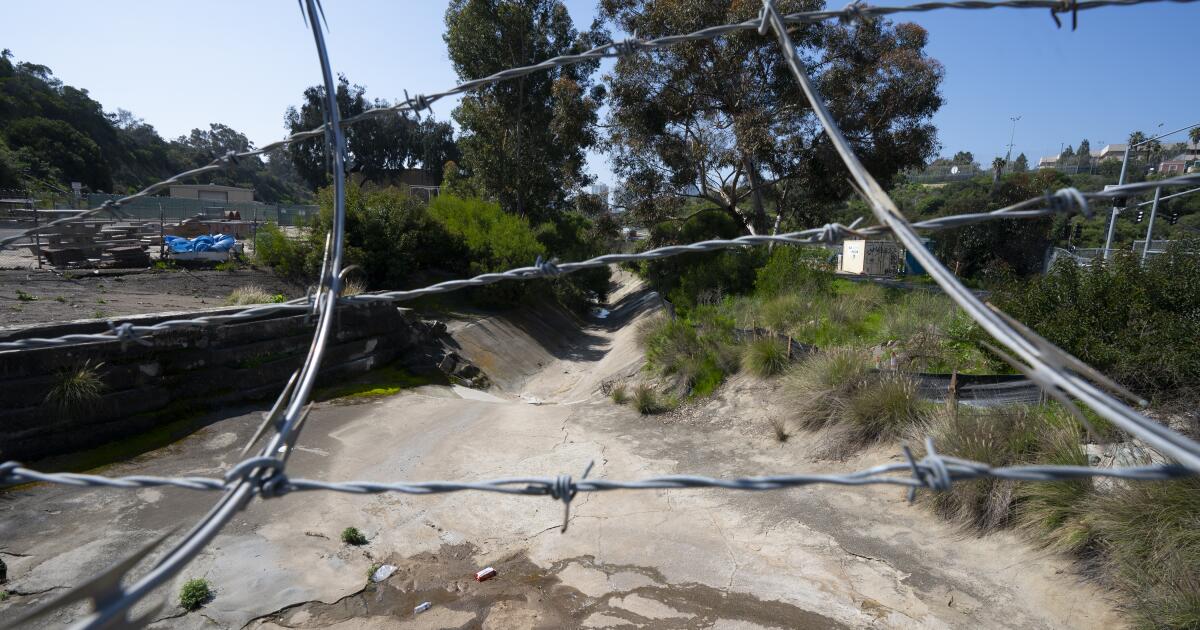[ad_1]
San Diego is finally clearing dozens of flood channels that it says have sorely needed maintenance for years, only after the Jan. 22 flooding overwhelmed city channels and destroyed many homes.
But the rare blitz of maintenance still leaves dozens of other channel segments that have not been touched in at least more than a decade, city records show.
San Diego’s stormwater department is maintaining 38 out of its more than 120 flood channel segments in the aftermath of the January storm — more than it ever has in a single year, according to city records. “Our focus now is on maintaining channels in advance of the remainder of the rainy season,” said Ramon Galindo, spokesperson for the department, in an email.
Among those getting maintenance are most, though not all, of the flood channel segments that make up Chollas Creek and its tributaries.

The area near Valeta Street and Famosa Boulevard in Point Loma on Wednesday.
(Nelvin C. Cepeda / The San Diego Union-Tribune)
The degree of emergency maintenance for each segment varies depending on its post-storm condition. The city said it completely cleared some segments while it partially maintained others.
But even after factoring in this emergency maintenance, the city still has not maintained at least 45 flood channel segments since at least 2011, The San Diego Union-Tribune found in an analysis of city documents.
Those include segments for the Tijuana River in San Ysidro and Otay Mesa, Nestor Creek in South Bay, Norfolk Canyon Creek in the College Area, the San Diego River in Point Loma, Soledad Canyon Creek in Sorrento Valley and Los Peñasquitos Creek in Rancho Peñasquitos, among others.
The city has no record of when it last maintained most of those segments. Yet the city had years ago documented issues for some of them, including moderate to heavy vegetation and multiple feet of accumulated sediment, according to city documents.
San Diego Deputy Chief Operating Officer Kris McFadden has said the Jan. 22 flood would have overwhelmed any stormwater system. But even stormwater officials have acknowledged that their system is underfunded, outdated and under-maintained.

Water flows down Chollas Creek near National Avenue on Feb. 6.
(Nelvin C. Cepeda / The San Diego Union-Tribune)
City residents have complained to the city for years about overflowing storm drains and flood channels that are packed with trash and vegetation, including full-grown trees.
The city collects little dedicated stormwater funding and has not asked voters to increase that funding since 1996. The city abandoned a ballot measure effort two years ago over concerns it wouldn’t pass. Now City Council President Sean Elo-Rivera is trying to place a stormwater tax hike on the November ballot.
Galindo said the stormwater department prioritizes which channels get maintenance first based on several factors, including their overall condition, likelihood of flooding, structural damage, erosion, ponded water, density of vegetation, trash and sediment deposition, and engineering analysis of the channel’s carrying capacity.
The level of post-flood emergency maintenance is “unprecedented” for the department, Galindo said. Typically the city only does routine maintenance on four channel segments and emergency maintenance on a few additional segments.
The emergency maintenance this winter has now covered most of the 60 channel segments that stormwater officials had said in November are in need of major maintenance, Galindo said.

Cleanup volunteers worked along the Chollas Creek bank and at street level in Southcrest on Saturday, Feb. 10.
(Nelvin C. Cepeda / The San Diego Union-Tribune)
City officials have said it’s difficult to perform maintenance more frequently because they must secure approval from several governmental agencies and arrange for environmental mitigation to offset the impacts of clearing flood channels — something they said is a time-consuming and expensive process.
Stormwater officials say it was only because of the Jan. 22 disaster that the city has been able to conduct so much maintenance. The city’s flood emergency declaration allowed the city to expedite the regulatory process, Galindo said.
[ad_2]


Leave a Reply
You must be logged in to post a comment.